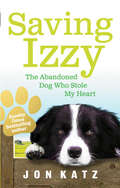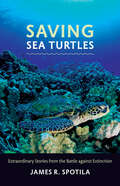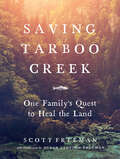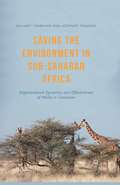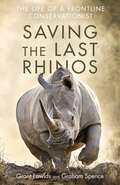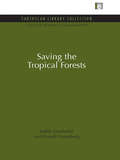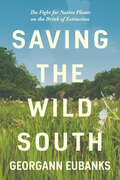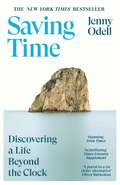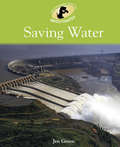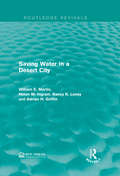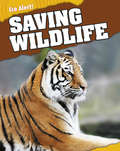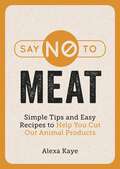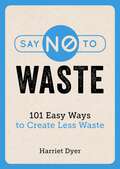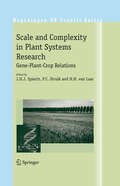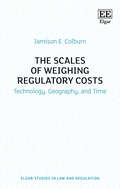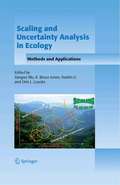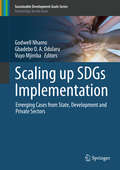- Table View
- List View
Saving H'non: Chang and the Elephant (Return to the Wild #2)
by Nguyen Thi TrangWhen Chang meets an elderly elephant named H’non, she makes a promise to rescue her from a lifetime of captivity. Together, they embark on a quest to find a new home where H’non can live as nature intended – wild and free.Created by environmental activist Trang Nguyen and award-winning manga artist Jeet Zdung, Saving H'non: Chang and the Elephant is an inspirational graphic-novel adventure, based on a true story, about a young conservationist who overcomes the odds to give H'non the elephant the life she deserves after 50 years of hardship.Chang’s daring story is for any young reader, animal lover and intrepid explorer who’s ready for adventure!PRAISE FOR SAVING SORYA: CHANG AND THE SUN BEAR– Nominated for the 2023 Yoto Carnegie Medal for Illustration– "A beautiful, moving and uplifting tale of perseverance and overcoming challenge, and how small steps can make a big difference.” - BookTrust– “I cannot praise this book enough.” Mat Tobin– "The epitome of wild and free." - Kirkus Reviews, starred review– "Stirring and gorgeously rendered, this eco-conscious tale is a superb purchase for all libraries." - School Library Journal, starred review
Saving Izzy: The Abandoned Dog Who Stole My Heart
by Jon KatzWhen Jon Katz hears about Izzy, a three-year-old Border collie kept alone in a field on an abandoned farm, his heart speaks louder than his head and he agrees to take him in.Once again Jon finds himself challenged by a difficult dog. Having found his human, Izzy wants to go with Jon wherever he may be, and jumps fences and chews through locks to do so. Jon has been through this before with his dog Orson, and isn't sure he can cope with the responsibility and potential heartache again. But Jon's motley collection of animals - from Jesus the baby donkey to Elvis the surprisingly sociable steer, as well of course as farm manager and Border collie Rose - form an ideal refuge for Izzy. And as Jon and Izzy decide they are perfect companions, Jon realises just how much life on the farm has taught him about patience, perseverance and love.Please note, Saving Izzy is the UK title for the book published in the US as Dog Days.
Saving Sea Turtles: Extraordinary Stories from the Battle against Extinction
by James R. SpotilaIn April 2007, eleven leatherback turtles captured the imagination of the public worldwide as they "raced" from Costa Rica toward the Galápagos Islands. Known as the Great Turtle Race, this event tracked these critically endangered sea turtles, drawing attention to their fragile status and generating data on the turtles vital to efforts to study and protect them.But the Great Turtle Race is just one of many tools marine conservationists use to inform people about the status, biology, and lives of the seven sea turtle species. Due to human actions, once-plentiful sea turtle population levels plummeted throughout much of the twentieth century, stabilizing somewhat only after Archie Carr and Jacques Cousteau popularized their plight. With Saving Sea Turtles, award-winning author James R. Spotila picks up where Carr and Cousteau left off, going inside the modern-day conservation movement to tell the tales of today’s sea turtle conservationists. He provides a complete overview of sea turtle biology and life cycles, discusses the human and natural world threats they face, and examines the new methods and technologies humans are using to save them. Throughout, Spotila dots the narrative with stories of real-life heroes who risk life and limb to understand, track, and conserve sea turtles across the globe.Spotila has been at the forefront of sea turtle research and conservation for decades. His inspirational story of dedicated individuals, creative endeavors, and adventure reveals what is being done and what else we must do in order to ensure that these fascinating animals continue swimming in the oceans.
Saving Sorya: Winner of the Yoto Carnegie Medal for Illustration 2023 (Return to the Wild #1)
by Nguyen Thi TrangWritten by scientist and environmental activist Trang Nguyen, Saving Sorya: Chang and the Sun Bear is an inspirational graphic novel adventure, based on a true story, about a young conservationist who overcomes the odds to save a sun bear.When endlessly curious Chang discovers a bear farm near her home in Vietnam, she decides to do everything she can to save wild animals – by becoming a conservationist! After teaching herself survival skills and learning all she can about the rainforest, Chang is finally accepted as a rescue centre volunteer. But her toughest challenge yet comes when she makes a vow to return Sorya – the sun bear she raised from infancy – back to the wild. Because despite being a different species, Sorya is Chang’s best friend. And letting a friend go is never easy, even when it’s the right thing to do.With breathtaking illustrations and STEM facts galore, Chang’s daring story is for any young reader, animal lover, and intrepid explorer who’s ready for adventure!
Saving Tarboo Creek: One Family's Quest to Heal the Land
by Scott FreemanExamine the most pressing environmental issues of our time through one family&’s detailed account of creek restoration. Equal parts heartfelt and enlightening, Saving Tarboo Creek explores how the Freeman family lived a more authentic, fulfilling, and natural life one sapling and one acre at a time.
Saving the Environment in Sub-Saharan Africa: Organizational Dynamics and Effectiveness of NGOs in Cameroon
by William T. Markham Lotsmart FonjongThis book describes how NGOs' efforts to promote sustainable development are affected by their funding, management strategies, and relationships with government, communities, and other NGOs. The authors explore implications for theory and offer suggestions for increasing NGO effectiveness.
Saving the Last Rhinos: The Life of a Frontline Conservationist
by Graham Spence Grant FowldsEach year, more than one thousand rhinoceroses are killed - in South Africa alone. There are fewer than 18,000 white rhinos and only 5,000 black rhinos left alive in the wild. The situation with regard to this corrupt, illegal war on wildlife is clearly critical.And what are rhinos killed for? Their horns - sold in shavings as a snake-oil 'cure' for colds or impotence. The going price is $16,000 a kilogram, but a rhino's horn is simply keratin, the same material as our fingernails, with no magical, medicinal properties.Grant Fowlds is a passionate conservationist on the front line of protecting these iconic animals - right now, against armed poachers; but in the longer term, too, through his work with schoolchildren, communities and policymakers. He is fiercely focused on highlighting the alarming increase in rhino poaching, a scourge which has put these mighty animals at serious threat of extinction. He is a partner of Rhino Art, founded by philanthropic adventurer Kingsley Holgate. Rhino Art's 'Let the children's voices be heard' project aims to gather the largest number of children's 'Art Voices' ever recorded, in support of rhino protection, and to use these heartfelt messages from the children of Africa and elsewhere in the world as a rallying cry against rhino poaching.Grant works closely with all the biggest local and global conservation agencies, including the World Wide Fund for Nature (WWF). He has hosted Prince Harry at his family's game lodge, Leeuwenbosch, and the prince is very supportive of Grant's work.
Saving the Planet Without the Bullshit: What They Don’t Tell You About the Climate Crisis
by Assaad Razzouk'Punchy, provocative and wonderfully readable' - David Shukman'Eye-popping and essential' - Rowan Hooper'A must-read' - Peter Stott Have you heard that you should plant trees to save the planet? Or buy carbon offsets when you fly? Or recycle plastic? Go vegan? Or not have children? What if all these actions were a distraction, no matter how well-intentioned?In this provocative manifesto, Assaad Razzouk shows that for too long our ideas about what's best for the environment have been unfocused and distracted, trying to go in too many directions and concentrating on individual behaviour. While some of these things can be useful, they are dwarfed by one big thing that simply has to happen very soon if we're to avoid major environmental breakdown: curtailing the activities of the fossil fuel industry.Full of counter-intuitive statistics and positive suggestions for individual and collective action, this ingenious book will change how you view the climate crisis.
Saving the Seed: Genetic diversity and European agriculture (Natural Resource Management Set)
by Renee VellveGenetic diversity is essential to the security of agriculture. Without the availability of a wide range of plant varieties and the genetic resources they contain, crops cannot adapt to combat the ever-changing threats of pests, diseases and climatic change. Yet, with the increasing industrialisation of modern agriculture, farming has become a business which centres on a handful of new, genetically similar 'super seeds'. Plants must evolve in order to survive, but modern agriculture has replaced diversity with uniformity, and security with vulnerability. Saving the Seed traces the decline of crop varieties in European farming and describes what is being done to safeguard genetic resources for the future. Conservation efforts by government and industry suffer from serious drawbacks, with wrangles over ownership and control of resources. The crucial work is being done by individuals and grassroots organisations, who largely go unrecognised and under-resourced. What is urgently needed are sound policies to promote the diversification of agriculture and an integrated strategy for safeguarding the genetic base of our food system. Saving the Seed contains the most up-to-date information available on genetic resources in Europe and on those working to save them. Renee Vellve is a researcher at GRAIN, a no-governmental organisation working to promote the sustainable conservation and use of genetic diversity, based on grassroots approaches to genetic resources management. Originally published in 1992
Saving the Seed: Genetic diversity and European agriculture (Natural Resource Management Set)
by Renee VellveGenetic diversity is essential to the security of agriculture. Without the availability of a wide range of plant varieties and the genetic resources they contain, crops cannot adapt to combat the ever-changing threats of pests, diseases and climatic change. Yet, with the increasing industrialisation of modern agriculture, farming has become a business which centres on a handful of new, genetically similar 'super seeds'. Plants must evolve in order to survive, but modern agriculture has replaced diversity with uniformity, and security with vulnerability. Saving the Seed traces the decline of crop varieties in European farming and describes what is being done to safeguard genetic resources for the future. Conservation efforts by government and industry suffer from serious drawbacks, with wrangles over ownership and control of resources. The crucial work is being done by individuals and grassroots organisations, who largely go unrecognised and under-resourced. What is urgently needed are sound policies to promote the diversification of agriculture and an integrated strategy for safeguarding the genetic base of our food system. Saving the Seed contains the most up-to-date information available on genetic resources in Europe and on those working to save them. Renee Vellve is a researcher at GRAIN, a no-governmental organisation working to promote the sustainable conservation and use of genetic diversity, based on grassroots approaches to genetic resources management. Originally published in 1992
Saving the Tropical Forests (Natural Resource Management Set)
by Judith Gradwohl Russell GreenbergThe destruction of the tropical forest is one of the major problems of our time. Vast areas are rapidly becoming wastelands which support only a few tough weeds, perhaps some cattle, and the farms allowed to the poor. This book provides a vision of hope: in Latin America. Africa. And South East Asia, growing numbers of people are developing techniques specifically designed to promote the wise use and preservation of remaining forest lands. However, these grassroots strategies are often ignored in favour of grandiose schemes which inevitably fail. This pattern must be broken now or the tropical forests will be lost forever. Published in association with the Smithsonian Institution. Preface by Michael Robinson, Director, National Zoological Park. Smithsonian Institution Originally published in 1988
Saving the Tropical Forests (Natural Resource Management Set)
by Judith Gradwohl Russell GreenbergThe destruction of the tropical forest is one of the major problems of our time. Vast areas are rapidly becoming wastelands which support only a few tough weeds, perhaps some cattle, and the farms allowed to the poor. This book provides a vision of hope: in Latin America. Africa. And South East Asia, growing numbers of people are developing techniques specifically designed to promote the wise use and preservation of remaining forest lands. However, these grassroots strategies are often ignored in favour of grandiose schemes which inevitably fail. This pattern must be broken now or the tropical forests will be lost forever. Published in association with the Smithsonian Institution. Preface by Michael Robinson, Director, National Zoological Park. Smithsonian Institution Originally published in 1988
Saving the Wild South: The Fight for Native Plants on the Brink of Extinction
by Georgann EubanksThe American South is famous for its astonishingly rich biodiversity. In this book, Georgann Eubanks takes a wondrous trek from Alabama to North Carolina to search out native plants that are endangered and wavering on the edge of erasure. Even as she reveals the intricate beauty and biology of the South's plant life, she also shows how local development and global climate change are threatening many species, some of which have been graduated to the federal list of endangered species.Why should we care, Eubanks asks, about North Carolina's Yadkin River goldenrod, found only in one place on earth? Or the Alabama canebrake pitcher plant, a carnivorous marvel being decimated by criminal poaching and a booming black market? These plants, she argues, are important not only to the natural environment but also to southern identity, and she finds her inspiration in talking with the heroes—the botanists, advocates, and conservationists young and old—on a quest to save these green gifts of the South for future generations. These passionate plant lovers caution all of us not to take for granted the sensitive ecosystems that contribute to the region's long-standing appeal, beauty, and character.
Saving Time: Discovering a Life Beyond the Clock (THE NEW YORK TIMES BESTSELLER)
by Jenny Odell**THE NEW YORK TIMES BESTSELLER**We're living on the wrong clock. And it's destroying us.'To read it is ... to experience how freedom might feel' Oliver Burkeman, author of Four Thousand WeeksOur life is dominated by the corporate clock that so many of us contort ourselves to fit inside. It wasn't devised for people, but for profit. We need to embrace a whole new concept of time: one that gives us and our planet a brighter future.In Saving Time, Jenny Odell, bestselling author of How to Do Nothing, examines how we got to the point where time became money. Taking inspiration from the pre-industrial, ecological and geological rhythms of our world, she offers us radical new models to live by that make a more humane, more hopeful existence seem possible.Now is our moment to rethink. And if we do, time might just save us.'An inimitable gift' Jia Tolentino, author of Trick Mirror'One of the most important books I've read in my life' Ed Yong, author of An Immense WorldSaving Time featured on the New York Times bestseller list 26.3.23
Saving Water: Saving Water (Environment Detective Investigates #1)
by Jen GreenWhy is water precious?What happens when water is scarce?What is being done to take care of water?The Environment Detective Investigates helps you to answer these questions and many more about saving water. Find out why living things need water, how people waste water and how we can help to save water.
Saving Water in a Desert City (Routledge Revivals)
by William E. Martin Helen M. Ingram Nancy K. Laney Adrian H. GriffinThis book was stimulated by and sets out to analyse a political battle over water pricing by a municipal system. Originally published in 1984, this title provides improved methods for demand function estimation where block rates are involved, suggests procedures for rational pricing of municipal water, and explains how politics can dominate when real decisions are made. Due to the additional virtue of this title being easy to read, it is ideal for students interested in environmental studies, economics, and policy making, as well as for those involved with municipal services and resource management in general.
Saving Water in a Desert City (Routledge Revivals)
by William E. Martin Helen M. Ingram Nancy K. Laney Adrian H. GriffinThis book was stimulated by and sets out to analyse a political battle over water pricing by a municipal system. Originally published in 1984, this title provides improved methods for demand function estimation where block rates are involved, suggests procedures for rational pricing of municipal water, and explains how politics can dominate when real decisions are made. Due to the additional virtue of this title being easy to read, it is ideal for students interested in environmental studies, economics, and policy making, as well as for those involved with municipal services and resource management in general.
Saving Wildlife (Eco Alert #6)
by Rebecca HunterLooks at some of the environmental issues facing the world today, discussing the problems and possible solutions.
Say No to Meat: Simple Tips and Easy Recipes to Help You Cut Out Animal Products
by Alexa KayeCutting out animal products has never been easier!From eco to ethical, there are plenty of sound reasons to eat less meat. It’s possible to make positive changes to your diet without radically altering your lifestyle – and you can still eat tasty, nutritious food without feeling like you’re missing out. This practical book is full of nutritional tips, lifestyle hacks and delicious meat-free recipes, so that you’ll find it easy to take the first step and make a difference.
Say No to Plastic: 101 Easy Ways to Use Less Plastic
by Harriet DyerWe’ve reached an environmental crisis point with plastic, and it’s time to take action. But is it possible to make positive changes without radically changing your lifestyle? Absolutely! This practical book suggests eco-friendly alternatives to plastic, including budget options, high-street substitutes and DIY ideas to help you drastically reduce your plastic consumption. With 101 simple ways to use less plastic, you’ll find it easy to take the first step and make a difference.
Say No to Waste: 101 Easy Ways to Create Less Waste
by Harriet DyerThe world is overflowing with waste. It’s time to take action. You can make positive changes without radically altering your lifestyle. This practical book suggests ways to reduce waste, including how to cut unnecessary packaging, patch up or recycle old household items and drastically limit food waste. With 101 simple ways to create less waste, you’ll find it easy to take the first step and make a difference.
Scale and Complexity in Plant Systems Research: Gene-Plant-Crop Relations (Wageningen UR Frontis Series #21)
The growing demand for food and increasing scarcity of fertile land and other resources (water, energy, etc. ) present multiple challenges to plant and crop scientists to meet the demands of future generations while protecting the environment and conserve biological diversity. Novel directions in linking basic plant sciences to crop and systems research are needed to meet the growing demand for food in a sustainable way. Crop performance can be changed by modifying genetic traits of the plant through plant breeding or changing the crop environment through agronomic management practices. To achieve that, systems analysis and modelling play an important role by integrating and evaluating new findings at the gene and plant level at higher scales of aggregation. Robust crop-physiological modelling can become an essential tool to use insights from functional genomics in explaining crop behaviour. Current crop models can predict crop performance over a range of environmental conditions. Recently QTL information has been incorporated into crop models, and this has proved the potential of narrowing genotype– phenotype gaps and of applying QTL-based models for the analysis of genotype-- environment interactions. To make further progress, model structure must be upgraded to allow for more physiological feedback features. Model input parameters should be designed to be potentially grounded in gene-level understanding. Integration of crop modelling into genetic and genomic researches can enhance the future position of crop physiology in ‘plant breeding by design’ (Yin, X.
The Scales of Weighing Regulatory Costs: Technology, Geography, and Time (Elgar Studies in Law and Regulation)
by Jamison E. ColburnThis book examines the calculation and evaluation of regulatory costs by regulators in accordance with a legislative mandate. A serious limitation in that enterprise, the possibility of technological change and innovation, often compromises those efforts and has long been under-appreciated in standard ‘cost-benefit analysis.’ Regulators who study the inducement of innovation and the avoidance of regulatory costs by the regulated often find significant cost-saving opportunities, leading to more stringent and more effective risk governance. Ultimately, the weighing of costs in this more elaborate model is more than simple welfare maximization. It views regulatory costs as important to society for a range of reasons, some grounded in fairness and some in deliberative process values, as a society seeks to minimize all costs over time. This analysis places the weighing of regulatory costs in context by comparing cost calculation methods and evaluative tools in three illuminating case studies. It assesses cost-factoring methods under different normative frameworks and highlights the role of technological innovation in cost minimization over time while considering regulatory costs that result from multiple regulatory tool choices. A single regulatory cost investigation is tracked from agency to legislative back to agency choice, outlining the steps to consensus-oriented cost factoring methods. Academic and professional lawyers in fields like environmental protection, food and drug safety, and workplace safety will find this an invaluable resource, as will researchers in disciplines dealing with judicial choice from economic or political theoretical frameworks and regulatory agencies charged with regulating risks.
Scaling and Uncertainty Analysis in Ecology: Methods and Applications
by Jianguo Wu K. Bruce Jones Harbin Li Orie L. LoucksThis is the first book of its kind – explicitly considering uncertainty and error analysis as an integral part of scaling. The book draws together a series of important case studies to provide a comprehensive review and synthesis of the most recent concepts, theories and methods in scaling and uncertainty analysis. It includes case studies illustrating how scaling and uncertainty analysis are being conducted in ecology and environmental science.
Scaling up SDGs Implementation: Emerging Cases from State, Development and Private Sectors (Sustainable Development Goals Series)
by Godwell Nhamo Vuyo Mjimba Gbadebo O. A. OdularuThis volume challenges global leaders and citizenry to do more in order to resource the implementation of the 2030 Agenda for Sustainable Development (AfSD) and its 17 interwoven Sustainable Development Goals (SDGs). Starting from the concept ‘we cannot manage what we cannot measure’, the book presents some cases showing how to draw national level baselines for the domestication and localisation of the SDGs seeking to provide a clear roadmap towards achieving the 2030 AfSD. Scaling up SDGs Implementation is targeted at the United Nations, national and state governments, sub-national governments, the corporate sector and civil society, including higher education institutes, labour groups, non-governmental organisations and youth movements. The book is cognizant of these institutions’ common, but differentiated responsibilities and capabilities within their socio-political, environmental and economic conditions. The book presents case studies of how the corporate sector has been scaling up SDGs implementation, from the tourism sector, insurance, to the aviation and agricultural sectors. To make sure that no one is left behind, the volume includes cases on solutions for pressing environmental and socio-economic problems ranging from cooperatives in Brazil to the conservation of springs in Zimbabwe. The matter of finding synergies between the climate SDG and the Paris Agreement’s Nationally Determined Contributions (NDCs) is elaborated at length. Lastly, the book discusses how institutions of higher education remain critical pillars in SDGs scaling up, with cases of curriculum re-orientation in South Africa to the rolling out of the Women’s University in Africa. In this context, this volume challenges every global citizen and organization to invest every effort into making the implementation of the SDGs a success as we welcome the second four to five year segment down the road to the year 2030.

